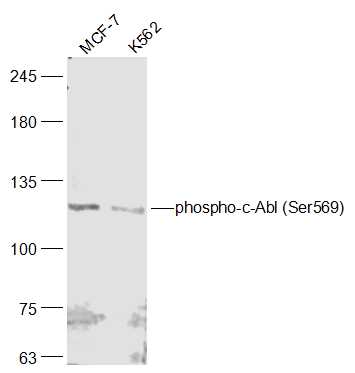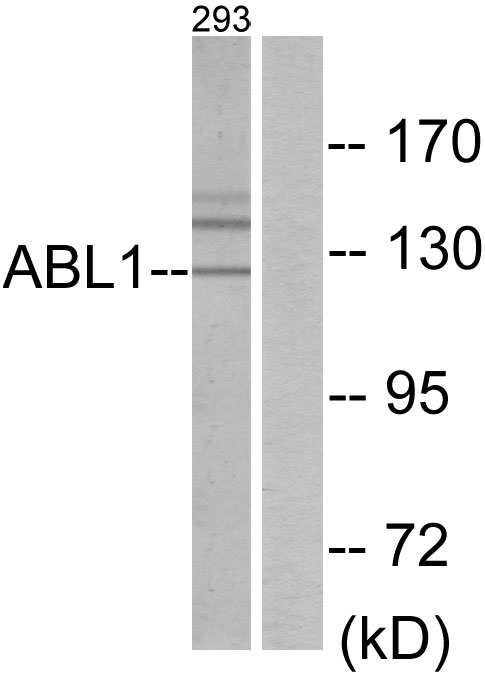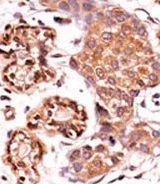c-Abl antibody
GTX111317
ApplicationsImmunoFluorescence, Western Blot, ImmunoCytoChemistry, ImmunoHistoChemistry, ImmunoHistoChemistry Paraffin
Product group Antibodies
ReactivityHuman
TargetABL1
Overview
- SupplierGeneTex
- Product Namec-Abl antibody
- Delivery Days Customer9
- Application Supplier NoteWB: 1:500-1:3000. ICC/IF: 1:100-1:1000. IHC-P: 1:100-1:1000. *Optimal dilutions/concentrations should be determined by the researcher.Not tested in other applications.
- ApplicationsImmunoFluorescence, Western Blot, ImmunoCytoChemistry, ImmunoHistoChemistry, ImmunoHistoChemistry Paraffin
- CertificationResearch Use Only
- ClonalityPolyclonal
- Concentration1 mg/ml
- ConjugateUnconjugated
- Gene ID25
- Target nameABL1
- Target descriptionABL proto-oncogene 1, non-receptor tyrosine kinase
- Target synonymsABL, BCR-ABL, CHDSKM, JTK7, bcr/abl, c-ABL, c-ABL1, p150, v-abl, tyrosine-protein kinase ABL1, ABL protooncogene 1 nonreceptor tyrosine kinase, Abelson tyrosine-protein kinase 1, BCR-ABL1 p190, BCR/ABL e8a2 fusion, BCR/ABL1 e1a2 fusion protein, BCR/ABL1 fusion, BCR/ABL1 fusion protein e3a1, BCR::ABL1 fusion protein, bcr/c-abl oncogene protein, c-abl oncogene 1, receptor tyrosine kinase, chimeric BCR::ABL1 protein, proto-oncogene c-Abl, proto-oncogene tyrosine-protein kinase ABL1, v-abl Abelson murine leukemia viral oncogene homolog 1
- HostRabbit
- IsotypeIgG
- Protein IDP00519
- Protein NameTyrosine-protein kinase ABL1
- Scientific DescriptionThe ABL1 protooncogene encodes a cytoplasmic and nuclear protein tyrosine kinase that has been implicated in processes of cell differentiation, cell division, cell adhesion, and stress response. Activity of c-Abl protein is negatively regulated by its SH3 domain, and deletion of the SH3 domain turns ABL1 into an oncogene. The t(9;22) translocation results in the head-to-tail fusion of the BCR (MIM:151410) and ABL1 genes present in many cases of chronic myelogeneous leukemia. The DNA-binding activity of the ubiquitously expressed ABL1 tyrosine kinase is regulated by CDC2-mediated phosphorylation, suggesting a cell cycle function for ABL1. The ABL1 gene is expressed as either a 6- or 7-kb mRNA transcript, with alternatively spliced first exons spliced to the common exons 2-11. [provided by RefSeq]
- ReactivityHuman
- Storage Instruction-20°C or -80°C,2°C to 8°C
- UNSPSC12352203
References
- Hung AC, Lo S, Hou MF, et al. Extracellular Visfatin-Promoted Malignant Behavior in Breast Cancer Is Mediated Through c-Abl and STAT3 Activation. Clin Cancer Res. 2016,22(17):4478-90. doi: 10.1158/1078-0432.CCR-15-2704Read this paper





![WB analysis of truncated GST-ABL1 recombinant protein (1) using GTX83337 c-Abl antibody [7B11D6].](https://www.genetex.com/upload/website/prouct_img/normal/GTX83337/GTX83337_20170912_WB_w_23061322_545.webp)